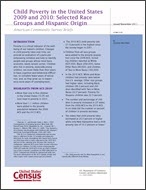Child Poverty in the United States 2009 and 2010: Selected Race Groups and Hispanic Origin
Child Poverty in the United States 2009 and 2010: Selected Race Groups and Hispanic Origin
Introduction
Poverty is a critical indicator of the well-being of our nation’s children. Changes in child poverty rates over time can provide an evaluation of a particular antipoverty initiative and help to identify people and groups whose most basic economic needs remain unmet. Children who live in poverty, especially young children, are more likely than their peers to have cognitive and behavioral difficulties, to complete fewer years of education, and, as they grow up, to experience more years of unemployment.1
Highlights from ACS 20102
- More than one in five children in the United States (15.75 million) lived in poverty in 2010.
- More than 1.1 million children were added to the poverty population between the 2009 ACS and the 2010 ACS.
- The 2010 ACS child poverty rate (21.6 percent) is the highest since the survey began in 2001.
- Children from all race groups were added to the poverty population since the 2009 ACS, including children reported as White (507,000), Black (259,000), Some Other Race (99,000), and children of Two or More Races (160,000).
- In the 2010 ACS, White and Asian children had poverty rates below the U.S. average. Other race groups had higher rates, including Black children (38.2 percent) and children identified with Two or More Races (22.7 percent). Poverty for Hispanic children was 32.3 percent.
- The number and percentage of children in poverty increased in 27 states from the 2009 ACS to the 2010 ACS. In no state did the number or percent of children in poverty decrease.
- Ten states had child poverty rates estimated at 25.0 percent or higher while only New Hampshire had a child poverty rate of 10.0 percent or lower.3
This report is one of a series produced to highlight results from the 2010 American Community Survey (ACS). It presents poverty estimates for children aged 0 to 17 based on data from the 2009 and the 2010 ACS. The report compares national- and state-level child poverty rates for all children and for children by race group and Hispanic origin for each state and the District of Columbia.4 The ACS also provides child poverty estimates for counties, places, and other localities.
__________
1 Duncan, G., and Brooks-Gunn, J. (Eds.). 1997. Consequences of growing up poor. New York, NY: Russell Sage Press; Wagmiller, Jr., R.L., Lennon, M.C., Kuang, L., Alberti, P.M., Aber, J.L. 2006. “The dynamics of economic disadvantage and children’s life changes.” American Sociological Review, 71(5), 847–866.
2 The ACS is conducted continuously and income data is collected for the 12 months preceding the interview. As such, throughout this report facts based on 2010 data refer to data collected in the 2010 ACS and not to the calendar year. Because the survey is continuous, adjacent ACS years have income reference months in common. For this reason comparing the 2009 ACS with the 2010 ACS is not an exact comparison of the economic conditions in 2009 with those in 2010. Comparisons should be interpreted with care. For more information on the ACS sample design and other topics visit <www.census.gov/acs/www>.
3 The child poverty rate for New Hampshire is not statistically different from Alaska.
4 Data for Puerto Rico are shown in the figures and tables.
Others in Series
Publication
Publication
Publication




